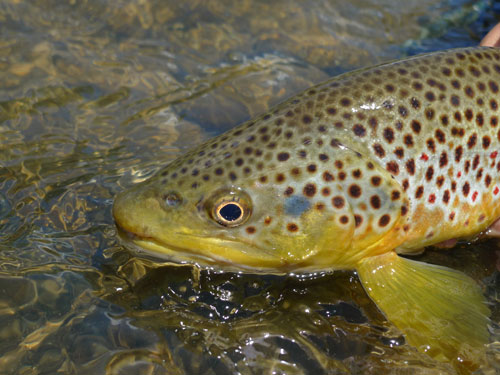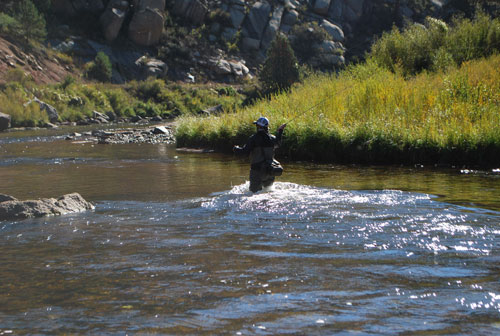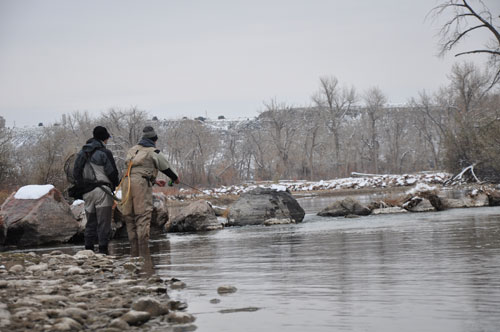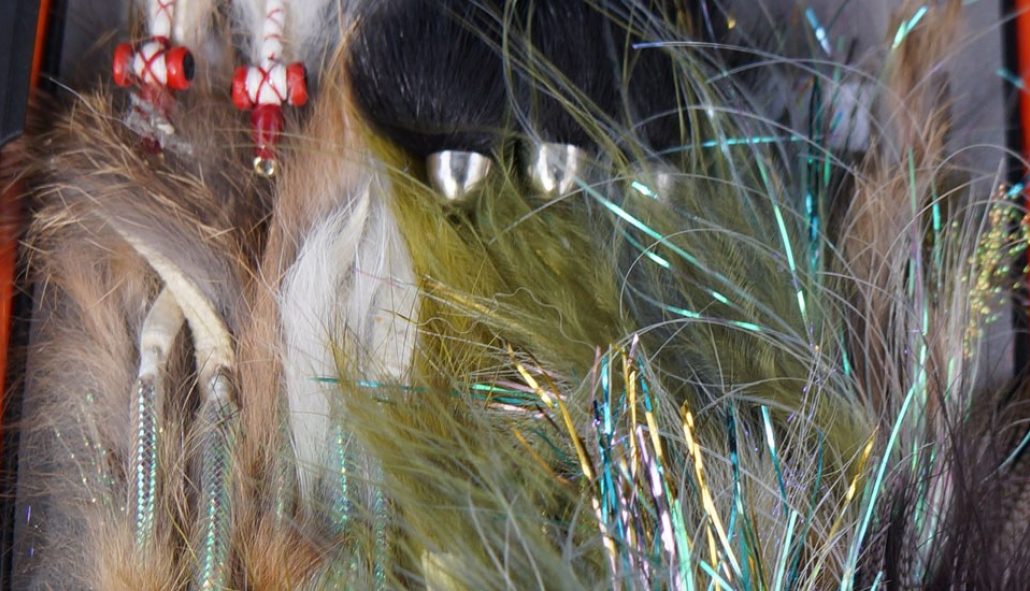Welcome to part 3 of our 3 part series devoted to Streamer fishing. Two weeks ago we discussed Choosing The Right Streamer To Fish. If you didn’t get a chance to read it click here. Last week we moved on to discuss Fly Rods, Lines, Leader/Tippet and Rigging. If you happened to miss that article, click here.
So here we are at part 3. We’ve learned how to pick a proper streamer to fish given the conditions. Learned how to properly set up and rig our streamer to fish…..so it’s time to get to the fun part. Let’s go fishing!
 When streamer fishing, we’re looking to get a reactionary strike out of the fish. Big fish like big meal…although you will find out sometimes little fish like big meals as well, but I digress. Our focus here is looking for the big one. Big fish know they need calories to survive. As you can imagine, a 4-6 inch meal packs way more calories than a bunch of little mayflies. When fish feed- and this doesn’t matter if we’re talking trout or tuna- part of the driving force behind feeding is the ratio of energy spent to attain the meal vs. energy gained from that meal. This is why when you find a trout sipping mayflies, it is most likely holding very still and calmly eating them. There’s not a ton of calories gained from a couple dozen mayflies, however virtually no energy was expended to get them. For streamer fishing, you will oftentimes see a fish follow your fly half way across the river because that fish knows, should it eat, that it will be getting a lot of calories as a result of the effort.
When streamer fishing, we’re looking to get a reactionary strike out of the fish. Big fish like big meal…although you will find out sometimes little fish like big meals as well, but I digress. Our focus here is looking for the big one. Big fish know they need calories to survive. As you can imagine, a 4-6 inch meal packs way more calories than a bunch of little mayflies. When fish feed- and this doesn’t matter if we’re talking trout or tuna- part of the driving force behind feeding is the ratio of energy spent to attain the meal vs. energy gained from that meal. This is why when you find a trout sipping mayflies, it is most likely holding very still and calmly eating them. There’s not a ton of calories gained from a couple dozen mayflies, however virtually no energy was expended to get them. For streamer fishing, you will oftentimes see a fish follow your fly half way across the river because that fish knows, should it eat, that it will be getting a lot of calories as a result of the effort.
The goal then, in simplest terms, is to present that “meal” to the fish in such a way that it looks like too good of a feeding opportunity to pass up. The biggest, most overarching theme/mindset/thought process you can have while streamer fishing is that you’re trying to make the fly mimic a live animal that will be very easy to eat, OR is going to provide a lot of calories to the fish.
We’ll break today’s lesson down into three parts A) Presentation B) Casting and Retrieval and C) Making On-Stream Fly Changes.
From a presentation standpoint, there are three main ways to present a streamer; Cross-Stream, Upstream, and Downstream. Each method can have its advantages and each method should be experimented with throughout the day. If the streamer bite is “on” during a particular day, you’ll most likely always find a presentation and retrieval method combination that gets better results than others.
Cross-stream presentations are without a doubt the most popular way to fish streamers, as well as the most “textbook”….oh and most fun. With this method you are typically making long casts and retrieving the fly back to you. This works great when the fish are active and in the mood to chase down your fly. Cross-stream presentations can be utilized with any of three main retrieval methods which we’ll discuss shortly. The biggest goal when making cross stream presentations is to keep your fly “profiled” in the water, as opposed to facing straight up or down stream. You want to look like a baitfish/sculpin swimming through the water column towards the bank/cover/boulders/etc.
Downstream presentation (which should really be thought of as a 45 degree angle downstream) work great when the fish are in the mood to chase, however maybe want their meal presented at a slightly slower pace. On a downstream presentation, you’re letting the current do some of the work for you and aren’t typically retrieving the fly all the way back to you. Cast either towards the bank and let your fly swing towards mid-river, or cast towards mid-river and let it swing towards the bank. You will impart action on the fly during these “swings”, however we will discuss that later. Downstream presentations are also great for short range shots, and target specific casts i.e. casting to a boulder pile (or other likely ambush spot), and stripping your fly out away in an attempt to get a strike. The advantage here comes from being able to keep a little more distance between you and the target, versus using a cross-stream cast to the same target.
 Lastly, Upstream presentations can work for both active and inactive fish, because you’re offering an easy meal either way you look at it. The goal here is to imitate a fleeing baitfish/sculpin that has clearly been disturbed and is seeking safety. Think about it, you’re a little fish and get scared from any number of things- wildlife, bigger fish or an angler. Turning tail and hauling downstream is obviously the quickest way to find safety versus charging upstream against the current. This is what you will be mimicking with an upstream presentation. Upstream presentations, like a downstream presentation, can also be great for shorter, accuracy casts to specific targets.
Lastly, Upstream presentations can work for both active and inactive fish, because you’re offering an easy meal either way you look at it. The goal here is to imitate a fleeing baitfish/sculpin that has clearly been disturbed and is seeking safety. Think about it, you’re a little fish and get scared from any number of things- wildlife, bigger fish or an angler. Turning tail and hauling downstream is obviously the quickest way to find safety versus charging upstream against the current. This is what you will be mimicking with an upstream presentation. Upstream presentations, like a downstream presentation, can also be great for shorter, accuracy casts to specific targets.
****Casting side note****No matter which presentation method you use, which in reality should be all of them throughout the day, none of them will be nearly as effective if you don’t make some slight adjustments to your cast. Streamers are an aggressive way of fishing a fly, and as such so should be your cast. Keeping your casting arm in tight to your body will lead to nothing but trouble. I like to have my tricep at a 90 degree angle to my torso when casting a streamer. Another way to think of this is that your reel will be even with your ear when casting (if not higher). Don’t be afraid to really extend your arm up and behind you on your backcast. Doing so will add substantial extra leverage and provide much more power as you begin your forward cast.
As far as retrieval goes, this again is broken down into three main categories for me: Stripping, Jigging, Drifting.- all three of which are fairly self explanatory.
Stripping is always a great starting place for your streamer fishing. With this method, you will be casting out and retrieving the fly back to you. Aside from being the most fun way to fish a streamer, it also allows you to cover water the fastest. Vary the speed of your retrieve, but in general keep your fly moving all the way back to you. This method of retrieval can be used with all three types of presentation methods. If stripping your fly back is resulting in fish following/swiping at your fly, but not totally eating, it’s time to switch retrieval methods.
Jigging is always my second option for streamer fishing. This can work great for all three methods of presentation, however my personal favorite way to jig a streamer is with a downstream or cross-stream presentation. This retrieval method still imparts noticeable action on the fly, however, given that it presents the fly at a slower speed through the water column, can help convert some of those “chases” into actual eats. When jigging your fly, the action will be imparted through a combination of twitching/bouncing the rod tip, or making short strips of the line without actually retrieving the line in. While stripping a fly can result in some fantastic chases/eats, jigging is without a doubt my personal most effective way to catch fish with a streamer.
Lastly, Drifting - or dead drifting. Some days the fish want a big meal, however don’t want to work for it that hard. I typically find myself dead drifting smaller to mid-sized streamers with a beadhead nymph off the back. Streamers made of bunny fur work the best for this method because the fur will still give some action to the fly. Dead drifting streamers isn’t something I ever find myself totally doing during a full day on the water. Rather, it is a retrieval method that I will incorporate into my fishing, especially on a day where the fish are preferring their streamer on the jig. If you jig your fly through likely looking water and get no results, making a final dead drift or two through that zone can be very effective at times in getting a strike. Dead drifting should be used on Cross-Stream or Downstream presentations. Upstream presentations can be quite tough on a dead drift because you essentially have no contact/feel with the fly and can miss strikes/get hung up on the bottom easily.
 ****Retrieval side note**** When retrieving a streamer, throw the high-stick nymph posture out the window. You want the tip of your rod pointed at the fly as you retrieve it. Depending on the current, this can be anywhere from your tip actually in the water, to a foot or two above.
****Retrieval side note**** When retrieving a streamer, throw the high-stick nymph posture out the window. You want the tip of your rod pointed at the fly as you retrieve it. Depending on the current, this can be anywhere from your tip actually in the water, to a foot or two above.
Finally, making effective on-water streamer adjustments can be the final ticket to putting the whole puzzle together. If you think back to my previous articles, even if the day is forecasted to be bright and sunny (which would make you think brighter streamers), you may still start with a darker black/olive color early in the morning to match the low light conditions. As the sun gets up and the day brighter, you will most likely want to switch to a lighter pattern. Conversely, if the morning is clear but an afternoon thunderstorm rolls in, you may want to switch to a darker color. From a size perspective, I also mentioned earlier that I usually start with as big a streamer that I think I can get away with. If I’m getting “follows” but no “eats”, this is my key to downsize my streamer. The biggest factor in on-water fly changes is to pay attention to what the fish are telling you. If they are eating one size/color combination with abandon and then suddenly shut off, ask yourself why? Paying attention to the small details, as opposed to simply sticking with the same streamer throughout the day, can make all the difference in the world in keeping the bite going.
I hope you’ve enjoyed this 3 part series on streamer fishing. Streamer fishing should be viewed as a tool, just like nymphs or dry fly fishing. Some days will be better than others. Some rivers are simply better for streamer fishing than others. Either way, having a general understanding when it comes to fishing this way is something any angler can master. With any luck, hopefully you now feel more prepared and knowledgeable to hit the water utilizing this fun and exciting way to catch fish!
From the Trouts Archives. Original post date: 10/27/14. Author: Kyle Wilkinson


 When streamer fishing, we’re looking to get a reactionary strike out of the fish. Big fish like big meal…although you will find out sometimes little fish like big meals as well, but I digress. Our focus here is looking for the big one. Big fish know they need calories to survive. As you can imagine, a 4-6 inch meal packs way more calories than a bunch of little mayflies. When fish feed- and this doesn’t matter if we’re talking trout or tuna- part of the driving force behind feeding is the ratio of energy spent to attain the meal vs. energy gained from that meal. This is why when you find a trout sipping mayflies, it is most likely holding very still and calmly eating them. There’s not a ton of calories gained from a couple dozen mayflies, however virtually no energy was expended to get them. For streamer fishing, you will oftentimes see a fish follow your fly half way across the river because that fish knows, should it eat, that it will be getting a lot of calories as a result of the effort.
When streamer fishing, we’re looking to get a reactionary strike out of the fish. Big fish like big meal…although you will find out sometimes little fish like big meals as well, but I digress. Our focus here is looking for the big one. Big fish know they need calories to survive. As you can imagine, a 4-6 inch meal packs way more calories than a bunch of little mayflies. When fish feed- and this doesn’t matter if we’re talking trout or tuna- part of the driving force behind feeding is the ratio of energy spent to attain the meal vs. energy gained from that meal. This is why when you find a trout sipping mayflies, it is most likely holding very still and calmly eating them. There’s not a ton of calories gained from a couple dozen mayflies, however virtually no energy was expended to get them. For streamer fishing, you will oftentimes see a fish follow your fly half way across the river because that fish knows, should it eat, that it will be getting a lot of calories as a result of the effort.  Lastly, Upstream presentations can work for both active and inactive fish, because you’re offering an easy meal either way you look at it. The goal here is to imitate a fleeing baitfish/sculpin that has clearly been disturbed and is seeking safety. Think about it, you’re a little fish and get scared from any number of things- wildlife, bigger fish or an angler. Turning tail and hauling downstream is obviously the quickest way to find safety versus charging upstream against the current. This is what you will be mimicking with an upstream presentation. Upstream presentations, like a downstream presentation, can also be great for shorter, accuracy casts to specific targets.
Lastly, Upstream presentations can work for both active and inactive fish, because you’re offering an easy meal either way you look at it. The goal here is to imitate a fleeing baitfish/sculpin that has clearly been disturbed and is seeking safety. Think about it, you’re a little fish and get scared from any number of things- wildlife, bigger fish or an angler. Turning tail and hauling downstream is obviously the quickest way to find safety versus charging upstream against the current. This is what you will be mimicking with an upstream presentation. Upstream presentations, like a downstream presentation, can also be great for shorter, accuracy casts to specific targets. ****Retrieval side note**** When retrieving a streamer, throw the high-stick nymph posture out the window. You want the tip of your rod pointed at the fly as you retrieve it. Depending on the current, this can be anywhere from your tip actually in the water, to a foot or two above.
****Retrieval side note**** When retrieving a streamer, throw the high-stick nymph posture out the window. You want the tip of your rod pointed at the fly as you retrieve it. Depending on the current, this can be anywhere from your tip actually in the water, to a foot or two above.